剑桥商务英语教程 unit-6 Day to Day Work汇总
- 格式:ppt
- 大小:387.00 KB
- 文档页数:49
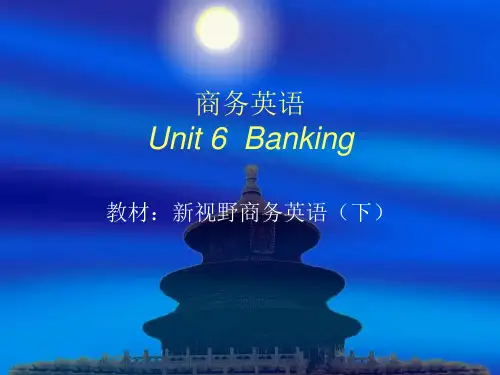
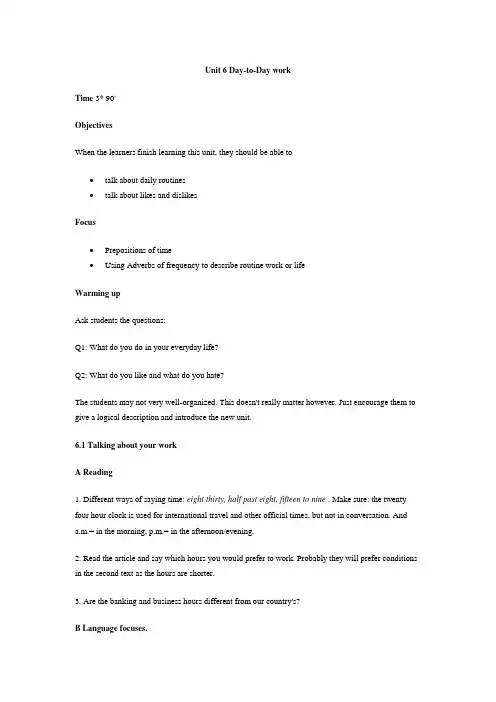
Unit 6 Day-to-Day workTime 3* 90'ObjectivesWhen the learners finish learning this unit, they should be able to∙talk about daily routines∙talk about likes and dislikesFocus∙Prepositions of time∙Using Adverbs of frequency to describe routine work or lifeWarming upAsk students the questions:Q1: What do you do in your everyday life?Q2: What do you like and what do you hate?The students may not very well-organized. This doesn't really matter however. Just encourage them to give a logical description and introduce the new unit.6.1 Talking about your workA Reading1. Different ways of saying time: eight thirty, half past eight, fifteen to nine . Make sure: the twenty four hour clock is used for international travel and other official times, but not in conversation. And a.m.= in the morning, p.m.= in the afternoon/evening.2. Read the article and say which hours you would prefer to work. Probably they will prefer conditions in the second text as the hours are shorter.3. Are the banking and business hours different from our country's?B Language focuses.This exercise focuses on prepositions of time.1. Look at the examples and elicit the rules.(Write the following on the board)1) at + time2) on + day/day with part of day3) in + month/part of day4) from morning till night, from 1998 to 20002. Further the practice. Give the correct prepositions for the following list of words:Sunday, July, four o'clock, the afternoon, midnight, Monday morning, three fifteen, December, April, Tuesday, Tuesday afternoon, 21 century, spring.3. Look at the photographs and establish what they do and where they work, suggesting working times and using this to present the following verbs:S/he starts/begins work at…S/he finishes work at…S/he do esn't work on…C SpeakingStudents do the conversations themselves. Go around to see whether all of them are get involved in the practice.D Writing1. Look at the beginning and end of the letter and make sure you know what you have to do.2. Write the letter, basing your information on someone you know, e.g. a relative or friend.6.2 Describing routinesA ReadingThe aim of this text is to develop learners' reading skills. It also presents adverbs of definite and indefinite frequency as will as a number of basic business activities.1. Look at the photograph and establish what Pam Lopker does. Then predict what she does in a typical day. Write on the board:She gets up at …She goes to work by …She gets to work at …She has lunch at…She fini shes work at …In the evening she …2. Read the text and compare it with your predictions. You do not need to understand every word to do this task.3. Reread the article in your own time and deal with any vocabulary problems.4. Do you think Pam Lopker works hard? Why?B Language focus.This exercise practice adverbs of indefinite frequency.1. Write on the board:I … get up at five o'clock.Ask students:Can you suggest a word which will fit in the gap? This should be an adverb of frequency ( don't would not be accepted). Can you give any other adverbs?2. Students look at the diagram and they should make sure they understand all the words.3. Reread the article and complete the sentences.Suggested answers :1) always, 2) sometimes, 3) never, 4) often, 5) usually4. Give the rule:subject + adverb of frequency + verb5. In pairs, learners tell each other about their day in analogy to the sentences about Pam Lopker. This ensures they are using the adverbs of frequency. When they are ready, put learners into new pairs and ask them to report on their first partner.C Language focusThis exercise practices definite adverbs of frequency, as in the example in the text: Customers or potential customers come to her office at least three times a week.1. Learners look at the table and point out the end position of definite adverbs of frequency, in contrast to the position of indefinite adverbs of frequency they met in the previous exercise. Check they understand the meaning of once and twice by asking a couple of questions, e.g. How often do we have English?2. Learners write some sentences about themselves based on other activities in the table.D WritingLearners write a paragraph about their own lives, using both indefinite adverbs of frequency and definite adverbs of frequency.6.3 Likes and dislikesA DiscussionThis activity introduces the theme of discussing likes and dislikes in your job and gives some vocabulary for discussing this.1. Learners look at what people say. Give some examples of perks, e.g. company car, free lunches, etc.2. Learners decide what is important for the situations listed below the pictures, rank their priorities, compare their choices and reach agreement.Suggested answers:Someone who wants to make a fortune: good boss, salary, perksSomeone with a family: hours, colleagues, holidays3. Elicit any other things not listed that might be important.B ListeningIn these three interviews learners hear people talking about some of the things from the vocabulary activity. It also introduces the language presented in the next section.1. Explain the rubric and make sure that learners understand when to put a tick(√)(important), a cross (×) (not important) and a dash (--) (no opinion/doesn't mention). Students read through the list and make appropriate marks in the You column.2. Learners compare what they have marked. Ask a few learners to say what they have marked to check that they are using the symbols correctly.3. Play the recording and learners mark the things talked about. Let them compare their answers with a partner before playing the recording again. They should note down how the person feels about each point.4. In the same way, do the other interviews.Suggested answers:C Language focusThis exercise focuses on verbs of liking and disliking followed by the –ing form.Learners look at the examples in the box. Establish that don't mind means that you don't feel strongly about something.1. Learners complete the sentences and add five more likes and dislikes, helping with vocabulary as necessary.2. Learners report back to the class. Introduce We both … and neither of us ..., e.g. We both like talking to people. Neither of us likes working on Saturdays.Sum-upIn this unit, we learnt:1. How to talk abut work.2. How to describe routines.3. How to describe likes and dislikes.AssignmentWrite a typical day in your life.。
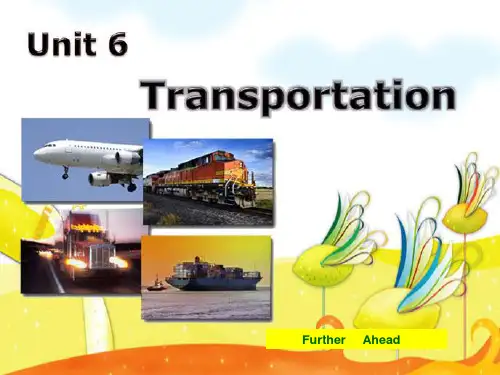
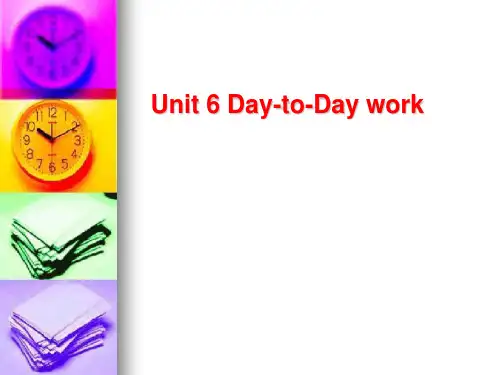
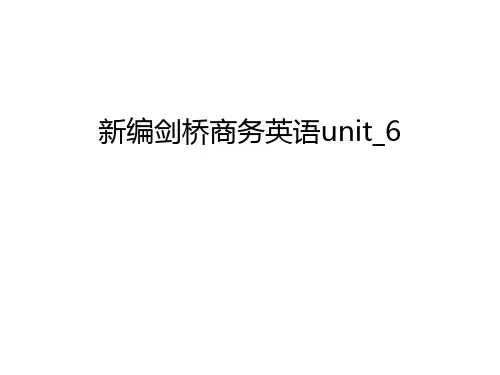
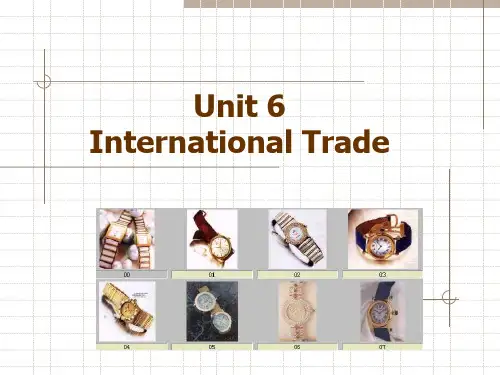
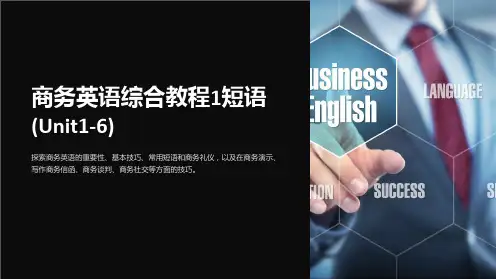

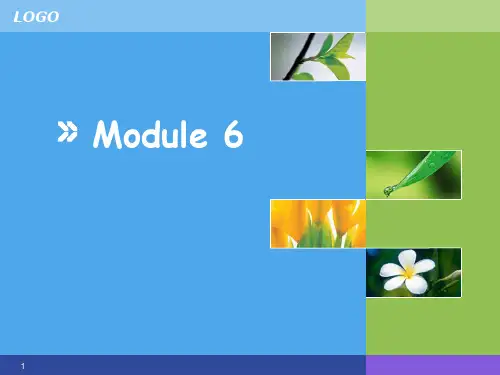

Unit 6a Reporting results报告结果I. Measuring performance1. Warm-upSome words about the performance of a company in the annual reportcompany performance 公司绩效performance evaluation 绩效评估annual report 年度报告pre-tax profits 税前利润breakeven 无亏损(的),盈亏相抵(的)volatile 可变的,不稳定的disposal 出售,出让balance sheet 资产负债表,平衡表exceptional item 非常项目operational margins 经营利润cost-cutting measures 降低成本的措施resource efficiency programme 资源增效计划sales volume 销售额trading volume 贸易额,交易额turnover 营业额restructure 结构重组streamline 使…有效率,精简cash surplus 现金盈余transformation programme 改革,改组计划earnings per share 每股收益dividend per share 每股分红assets 资产2. ListeningListen to a television report about the performance of the UK supermarket chain Budgens and answer the questions on p83.Listen to the second half of the report again and complete the graph on p84 representingBudgens's share-price from February 98-99.TapescriptSo, let’s have a look at how the markets are doing with Jenny.Thanks, Tony. Well, we’ll begin with Budgens, the supermarket chain. They’ve reported their results today. For the six months, pre-tax profits rose sharply by 9.8%, which brought the final figure for the year to just over 6.3m. That’s up from just 5.8m last year. The dividend is up. If you’re one of their shareholders, you can expect half a penny per share. Bugdgens has got 163 stores and three now actually sell petrol, so they do seem to be expanding. They’ve also just spent half a million pounds on buying something called Teleshop services, which specializes in developing computer-based home shopping. However, the business is only operating at break-even and isn’t expected to do much more this year, it has to be said.Now, let’s take a look, shall we, at how budgens ’ share price has done over the last 12 months. As you can see, it’s been pretty volatile. After steady progress throughout the first half of the year, it really shot up at the end of the summer, when everyone thought there’d be a takeover. At the height of the rumours, in September, you can see that shares peaked at just over 80 pence. The takeover didn’t happen.though, and the price collapsed. By mid-October it had fallen as far as the 55 pence mark. The shares recovered slowly to 65 pence by November, but then they went into steady decline again for the next two months, down once again to the 55 pence mark. However, news of good trading results has meant that shares have improved again this year. And it has to be said, the share price is marginally up on last February. So shareholders are in profit over the 12-month period. And if we look at the budgens shares today, they’re up slightly by 1.3 pence at 67 and a half.3. V ocabulary: verbs/nouns as well as adverbs describing change股票涨跌:shoot up 猛涨shares peak at 股价达到最高点the price collapses 股票蹦盘the price falls/goes down 股价下跌shares recover/rally 股价回升go into steady decline 稳步下跌share price is marginally up 股价微升shares are up slightl y by…股价微升常用的概括图表信息的词组和表达方式A.上升趋势Verbs/ nounsto increase / an increaseto go upto grow / a growthto jump / a jumpto leap / a leapto peak/ a peakto reach a peak / a peakto soar / a soarto rise / a riseto upsurge / an upsurgeto upswing / an upswingto improve/ improvementto shoot upto rocketto recover/ a recoveryB. 下降趋势to collapse / a collapseto decline / a declineto drop / a dropto decrease / a decreaseto fall / a fallto go downto reach a low point / a low pointto reduce / a reductionto slump/ slumpc. 程度a. 升降程度较大a great deal /big/a lotapparent / apparentlyclear / dearlyconsiderable / considerablyimportant / importantlydramatic / dramaticallygreat /greatlydrastic / drasticallymarked / markedlymuchobvious / obviouslyfastquick / quicklyrapid / rapidlyremarkable / remarkablysharp ,/sharplysignificant / significantlystrong / stronglysudden / suddenlyb. 升降程度较小a bita littlefractional / fractionallygentle / gentlygradual / graduallyhardlylittleslight / slightlyslow / slowlysmallsteady / steadilyc. 平稳状态to be hardly changedto have little changeto keep steadyto level offto remain constantto remain unchangedAdverbsslightly/moderately /steadilysharply/ considerably/ greatly/significantly/dramatically/drasticallyquickly/rapidly/slowlyA slight increase, a sudden collapse, a dramatic/sharp/strong rise, a steady decline, a gradual rise, a jump, remain stable/steady, stay/level off总结:猛升:Skyrocket, Soar, jump猛降:plunge, dive, collapse下降:fall, drop, decline,上升:increase, grow, rise,升幅:growth rate, scale of increase/decline平稳:stable, steady, same, level off, stay,remain例句Interprete曲线图(line chart),柱状图(bar chart),饼状图(pie chart),和表格(table)Truck sales rose steadily from October to December.A steady fall in sales during November and December followed the sharp increase in October.Truck sales dropped during November but increased again in December to exceedOctober sales.Truck sales hardly changed throughout the period, except for a slight increase in November.A slow but steady increase was followed by a sharp fall and an increase towards theEnd.Truck sales dropped down in October, but remained unchanged for the rest of the period.4. SpeakingSs work in pairs to describe the graph/ bar-chart to each other for their partner to draw.II. Annual reportsAbout the topic of annual reportsAn annual report is written for shareholders to inform them of the financial situation of the company. It is usually a glossy publication which aims to promote a positive image of the company. It includes information on company activities and major developments over the year as well as financial information about the company, such as balance sheets and profit and loss accounts.Read the extract on p85 and match each sentence with one of the extracts.Exam focus: Reading Test Part OneCandidates read four topic-related texts (A-D) and match each of the seven statements with the relevant text. This tests ability to read for gist and specific information.Candidates read the four text and then the statements. They then focus on each text in turn, reading for detail and finding statements which match. Finally, candidates re-read each statement and check their answers. Candidates should check they have used all the statements once only and that they have not made careless errors nothing down the letters.AssignmentWrite a 120-140 word report comparing the two companies and recommending the most suitable. It should be clear and concise and include language for describing trends and cause and effect, where appropriate.III. Essential vocabularyDescribing performanceacquisitionannual reportassetschairman's statementcost-cutting (measures)disposaldividendmergerto offsetto restructurerevenuesales volumeshare priceto streamlinetrading resultstrading volumeUnit 6b Environmental reportWarm-upAsk Ss if they know anything about pollution and the words connected with it.Ss read the questionnaire. Add up the total score. Then turn to p147 for an assessment of the company's Environmental impact.Words and expressions for reference:readjust energy consumption policy调整能源消费政策formulate waste management guidelines制定垃圾管理政策collect and separate the waste对垃圾进行收集和分类reduce disposables减少一次性用品develop environmentally-friendly packing开发环保型包装use fewer plastic bags少用塑料袋to green the environment wit plants通过种树栽花绿化环境water saving system节水系统reduce energy consumption减少能源消耗Environmental performanceListening Ss listen to a presentation about ICI's Environmental record and answer multiple-choice questionsGood morning. Today we’re going to look at ICI’s environmental programmes and environmental performance since 1990. I’d like to begin with some background to ICI’s environmental projects. Then we’ll go on to look at our Challenge 2000 project. And finally, we’ll turn to the results of these programs.Now the story really began in the 1980s when people started becoming more concerned about environment issues. The first ICI environmental project was a result of the realization that, as a major player in the chemicals industry. ICI would have to address these growing public concerns. So, in 1900 we presented our shareholders with a program to reduce the environmental impact of our worldwide activities. Many of the steps we took back then have since become government legislation. The project included some very ambitious targets for improving the company’s environmental performance. We realised that these goals demanded significant investment, so we committed the largest share of our annual £500 million Safety, Health and Environment budget to the project. Since 1990 we’ve spent about 200 million each year on environmental improvements. As things developed, we soon realised that there were no cheap options or quick fixes. Therefore, we began directing this expenditure to the biggest problems, where solutions would bring the biggest improvements. And then, in 1995, we assessed our performance and set ourselves equally demanding objectives for the next five years. These formed the basis of our Challenge 2000 project.If you’d like to look at the screen, you’ll see the four main objectives of Challenge 2000. As you can see, our first objective is to ensure that by the year 2000 all our business comply with the relevant environmental regulations in each of the countries in which their products are sold. This applies to all our new and existing plants throughout the world. Our second objective is to improve energy efficiency. Now, here, we decided that by the year 2000 we would reduce our energy consumption by 10%. The starting point for this reduction would be the 1995 level. Moving on to the next objective, ICI intends to have the environmental impact of its business bythe year 2000. I’m sure you’ll understand exactly how ambitious this is, but we feel it demonstrates the importance of the issue. To achieve this target, we decided to concentrate on those wastes which pose the greatest threat to the environment and give their reduction the highest priority. And finally, our last objective is to ensure that all our business have what we call Product Stewardship Programmes. These programmes are a tool for managing all our chemicals throughout their complete product life cycle. They’ll provide up-to-date records of all the chemicals that we use and handle. And what’s more, they’ll ensure that all labels and public information are printed in the languages of our customers. The results of these programmes will be published each year in a special report.Now, it’s clear that growing public concern about the future of the environment will affect government thinking--- and no-one in the industry doubts that tougher legislation is to come. That’s why Challenge 2000 is such an essential part of ICI’s strategic development. With the improvements we’re making today, we can feel confident about fulfilling the legal obligations of tomorrow. At ICI we realise that we have a commitment not only to our customers, employees and shareholders, but also to the communities in which we work and produce our goods.So now, I’d like to turn to the results of the …Environmental performance环境绩效Summarize the four main points of the Challenge 2000 project. Ss rank the four points according to the extent to which the initiatives would make a difference to the environment. Ss should explain the reasons for their ranking.Suggested answer:By 2000 ICI aims to:Meet all local Environmental regulations (in countries where ICI operates and will operate). Reduce energy consumption (by 10% of 1995 figure).Halve its Environmental impact (by reducing the most dangerous type of waste).Ensure all its businesses have Product Stewardship Programmes ) to improve information abut chemicals used by the company).Phrases used when making presentationsPresentationA presentation is a formal talk to one or more people that "presents" ideas or information in a clear, structured way. People are sometimes afraid of speaking in public, but if you follow a few simple rules, giving a presentation is actually very easy.The following phrases are useful when making presentations.Introducing your talkToday we're going to look atI'd like to begin withReferring to visualsIf you'd like to look at the screen, you'll seeAs you can see fromSignalingMoving on toNow I'd like to turn toessential vocabularyby-product副产品to comply with (regulations)energy consumption能源消耗energy-efficient节能的Environmental impact环境影响Environmental issues环境问题Environmental legislation环境立法Environmental programme环保项目to fulfil (an obligation)承担义务hazardous/non-hazardousproduct life cycle产品寿命周期subsidyto subsidizeto reach a target达到目标AssignmentSs work in groups. Each group prepares a short presentation using the information given on p90.More expressions:SignpostingFunctionLanguageIntroducing the subjectI'd like to start by...Let's begin by...First of all, I'll...Starting with...I'll begin by...Orderingstly...First of all...then...next...after that...finally...To start ter...to finish up...Finishing one subject...Well, I've told you about...That's all I have to say about...We've looked at...So much for......and starting anotherNow we'll move on to...Let me turn now to...Next...Turning to...I'd like now to discuss...Let's look now at...Analysing a point and giving recommendationsWhere does that lead usLet's consider this in more detail...What does this mean for ABCTranslated into real terms...Giving an exampleFor example,...A good example of this is...As an illustration,...To give you an example,...To illustrate this point...Dealing with questionsWe'll be examining this point in more detail later on...I'd like to deal with this question later, if I may...I'll come back to this question later in my talk...Perhaps you'd like to raise this point at the end...I won't comment on this now...Summarising and concludingIn conclusion,...Right, let's sum up, shall weI'd like now to recap...Let's summarise briefly what we've looked at...Finally, let me remind you of some of the issues we've covered... If I can just sum up the main points...饼状图注意顺序例题You work for Marks & Spencer, Britain’s leading retailer. Your company plans to inv est in a local retail market. You are asked to assess the local purchasing power.●Read the following pie chart which demonstrates the local family income after taxes.●Use the information in the chart to write a report (about 100 - 120 words) interpreting thechart, discussing the prospects of your company’s investment in the local retail market, and explaining the conclusion you reach from the information in the chart and how the chart supports your conclusion.Write on your Answer Sheet.Local Family Income After Taxes审题:你的任务:you are asked to assess the local purchasing power.首先明白pie chart说的是什么东西,local family income after tax然后要写什么:1. interpret the chart to purchasing power.2. and then with the purchasing power, discuss prospect of investment. 3. Explain how you reach the conclusion from the chartincome ---purchasing power--- prospect of investmentIntroductionThe report I am submitting aims to have some rough ideas of the future investment in the local retail market.FindingsThe chart shows that there are approximate 37% of the families with an income over 10,000, which is fairly acceptable。
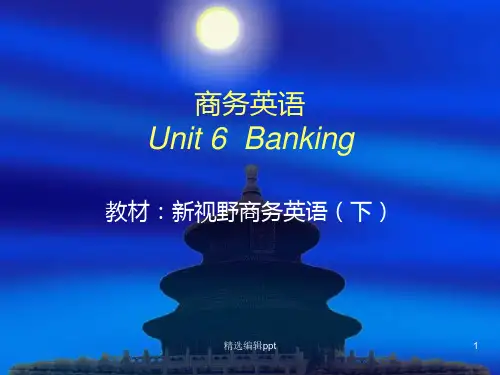
Open your mind打开你的心灵Bosses should consider requests for flexible working from employees with children under six. So embrace the benefits: “Twice as much experience, skills, brainpower and energy.” Savage says老板应该考虑的要求灵活的工作员工,6岁以下儿童。
所以拥抱的好处:“两倍经验、技能、智力和精力。
”野蛮人说Plan for disaster灾难计划Always discuss the worst-case scenarios.When Margaret Mills, a teacher, lost her job-share partner because of a family illness, a return to full-time work seemed inevitable. ‘We had been over-optimistic. I did manage to find someone else who fitted in with me, but I was very lucky.’总是讨论这个最坏的情况。
玛格丽特•米尔斯老师时,失去了她的家庭分工合作伙伴因为疾病,恢复全职工作似乎是不可避免的。
“我们已经过于乐观。
我设法找别人在跟我装,但我很幸运Get organised得到组织Plan the system for handing work over carefully and play to each other’s different strengths. Delegate the workload according to each other’s particular skills and qualities.仔细计划上交工作制度,发挥彼此的不同优势。